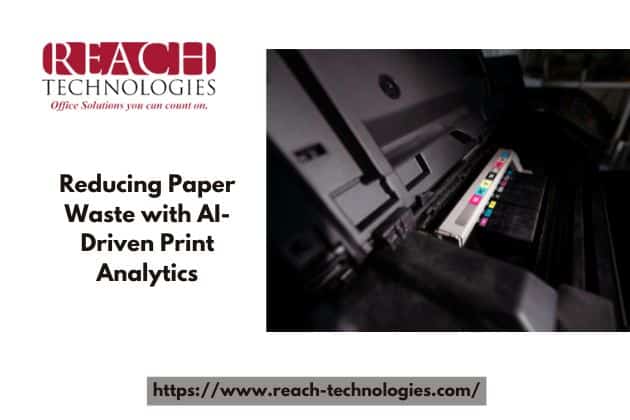
In a rapidly digitalizing world, paper waste continues to challenge organizations striving for sustainability and cost efficiency. Despite the rise of digital workflows, offices still produce massive amounts of unnecessary printouts — from outdated reports to duplicate documents. The solution lies in AI-driven print analytics, a transformative technology that empowers businesses to analyze, optimize, and control print behavior for a greener and more efficient future.
The Growing Impact of Paper Waste on Businesses
Every sheet of paper printed represents more than just operational cost — it’s a footprint on the environment. Paper waste contributes to deforestation, energy consumption, and landfill buildup, while also inflating business expenses.
A typical organization wastes up to 30% of its printed materials, often due to:
-
Unnecessary printing of drafts
-
Forgotten or abandoned print jobs
-
Excessive color printing
-
Poor print policy enforcement
By addressing these inefficiencies through AI-driven print analytics, companies can achieve measurable improvements in cost reduction, resource management, and environmental sustainability.
Understanding AI-Driven Print Analytics
AI-driven print analytics is a next-generation approach that uses machine learning algorithms, predictive modeling, and real-time data tracking to understand and optimize how printing resources are used across an organization.
Through continuous data collection from printers, copiers, and print servers, AI systems provide:
-
Detailed usage insights by user, department, or device
-
Behavioral analysis to identify print patterns and inefficiencies
-
Predictive alerts for maintenance and supply needs
-
Recommendations for reducing unnecessary print jobs
This powerful combination of data and intelligence enables organizations to make informed, proactive decisions that align with both cost-saving and sustainability goals.
How AI Helps Reduce Paper Waste
AI doesn’t just monitor — it transforms print environments into intelligent ecosystems. Below are the key ways it drives reduction in paper waste:
1. Detecting and Preventing Unnecessary Printing
AI analyzes print habits to spot redundant jobs and recommend digital alternatives. For example, it can suggest sharing documents via cloud collaboration instead of printing, or automatically flagging multi-page print jobs that could be condensed.
2. Enforcing Smart Print Policies
Automated policy enforcement allows businesses to apply restrictions based on AI insights — such as converting color prints to black and white, enforcing duplex (double-sided) printing, or limiting printing for non-essential documents.
3. Predictive Maintenance for Optimal Efficiency
Printer downtime and malfunctions often lead to reprints and wasted paper. AI-driven analytics predict maintenance needs, ensuring devices are operating at peak performance, minimizing reprints and misprints.
4. User Accountability and Behavioral Change
When employees are aware that their printing habits are monitored, they become more mindful and responsible. AI systems provide personalized reports and recommendations, promoting a sustainable mindset and fostering eco-friendly office culture.
5. Data-Driven Sustainability Reporting
AI tools generate sustainability dashboards that highlight environmental impact reductions, helping businesses measure carbon footprint savings and report progress toward corporate social responsibility (CSR) goals.
The Economic Benefits of Print Analytics
While the environmental advantages are clear, the financial returns from implementing AI-driven print analytics are equally compelling.
Businesses leveraging this technology can expect:
-
Up to 25–40% reduction in total printing costs
-
Extended equipment lifespan due to balanced usage
-
Lower supply expenses from reduced toner and paper consumption
-
Improved employee productivity through automation and efficiency
The ability to correlate printing behavior with cost centers allows companies to reallocate resources strategically, improving overall profitability.
Integration with Managed Print Services (MPS)
The true power of AI-driven print analytics emerges when combined with Managed Print Services (MPS). Together, they create a smart, secure, and sustainable print infrastructure.
An integrated solution provides:
-
Centralized print management with real-time insights
-
Automated device provisioning and monitoring
-
Predictive supply ordering based on actual usage data
-
Continuous improvement through AI feedback loops
This partnership ensures that organizations stay compliant, efficient, and environmentally conscious, while maintaining consistent print performance across all departments.
Enhancing Data Security and Compliance
Print analytics also strengthens document security — a crucial consideration in industries handling sensitive data such as healthcare, finance, and government.
AI identifies unusual print activities (like mass printing of confidential documents) and can trigger alerts or automatic holds. Additionally, it supports compliance with regulations such as GDPR and HIPAA by ensuring secure document release and access control.
By reducing unclaimed printouts and unauthorized access, AI not only cuts waste but also protects organizational data integrity.
AI-Driven Print Analytics in Action
A leading global enterprise implemented AI-powered print analytics across 200 offices and achieved remarkable results:
-
35% reduction in paper usage within the first year
-
20% decrease in printing costs
-
Improved accountability through user-level reporting
-
Automated optimization of underused printers
These measurable outcomes highlight how data intelligence can transform everyday print management into a strategic sustainability initiative.
Steps to Implement AI-Driven Print Analytics
Businesses looking to embrace AI-powered print management should follow a structured approach:
-
Audit Current Print Environment – Identify existing devices, workflows, and usage patterns.
-
Deploy Smart Print Monitoring Tools – Integrate analytics software with networked printers.
-
Define Sustainability and Efficiency Goals – Align print policies with environmental and cost objectives.
-
Leverage AI Insights – Use automated recommendations to modify behaviors and reduce waste.
-
Track and Refine Continuously – Review reports regularly to ensure consistent optimization.
Through continuous improvement and employee engagement, organizations can establish a sustainable print culture powered by data and innovation.
The Future of Sustainable Printing
As artificial intelligence evolves, so will its role in sustainability-driven print management. Future systems will integrate with IoT sensors, cloud analytics, and carbon accounting platforms, enabling real-time sustainability tracking and dynamic optimization.
AI will also enable automated document lifecycle management, ensuring only essential prints are generated and securely destroyed when no longer needed. The result? Zero-waste, carbon-neutral printing environments that align with global green initiatives.
Conclusion: Partner with Reach Technologies for a Smarter, Greener Print Strategy
At Reach Technologies, we are committed to helping organizations achieve sustainable printing excellence through AI-driven print analytics and managed print solutions. Our technology-driven approach helps businesses reduce paper waste, lower operational costs, and enhance productivity — all while supporting environmental responsibility.
Let us help your organization take control of printing behavior, uncover cost-saving opportunities, and lead the way toward a smarter, greener, and more efficient future.
Contact Reach Technologies today to learn how AI-powered print analytics can revolutionize your print environment and support your sustainability goals.
